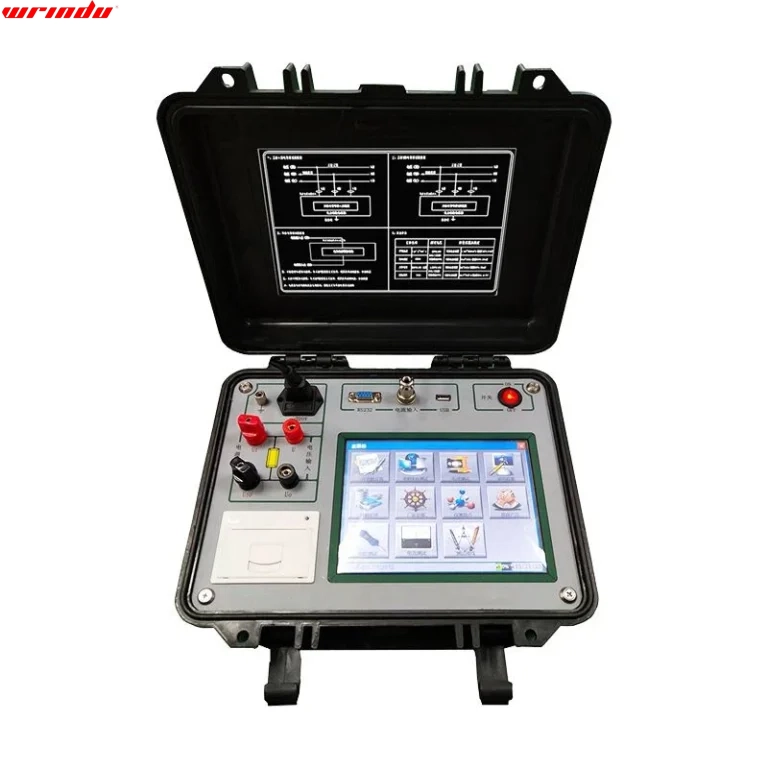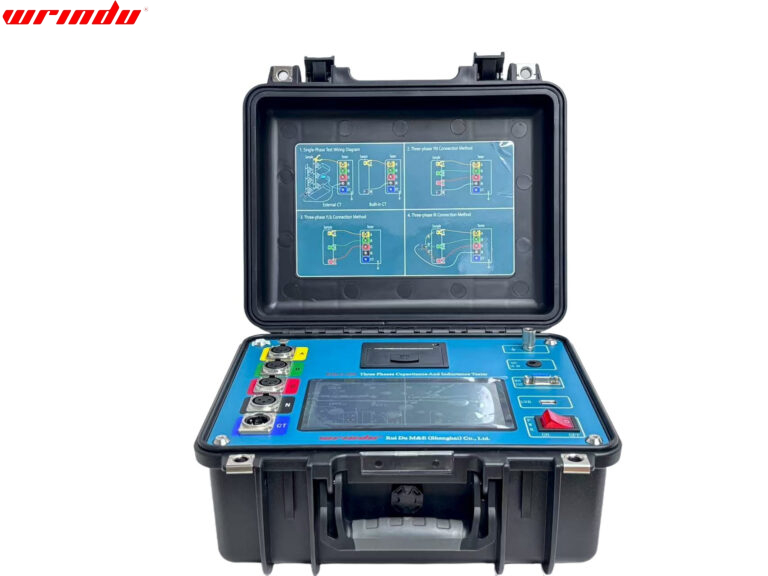Generator detection testing
As a Reactive Compensation and Generator Testers manufacturer, Wrindu specializes in the design and production of testing equipment. With many years of export experience, we have provided high-quality testing equipment to more than 50 countries, including the Ethiopian Electricity Company, Uganda Electricity Company, and Dubai Electricity Company. Not only do we offer our own branded products, but we also provide customized production according to our customers’ specific needs. You can learn more about our products below. If you have any special requirements, please feel free to contact us, and we will provide you with professional pre-sales and after-sales services.
What are advantages of Reactive Compensation And Generator Tester?
Non-Intrusive Measurement Technology
The unique non-intrusive design allows for precise measurement of capacitors and inductors without disrupting the circuit, greatly enhancing the convenience and safety of measurements. It is particularly suitable for continuous monitoring in production environments, reducing downtime and ensuring the stability of production processes.
Multi-Functional Data Display
Our instrument not only provides accurate measurement of capacitance or inductance values but also displays up to six key electrical parameters in real-time, including voltage, current, power, and frequency. This comprehensive data support allows for more in-depth fault analysis and a more thorough assessment of circuit performance.
High-Definition Touchscreen Display
Equipped with an 8.0-inch high-resolution touchscreen, combined with an intuitive graphical interface and menu prompts, the display ensures easy operation even in complex environments, greatly enhancing the user experience and ensuring the accuracy and efficiency of data reading.
Robust Data Storage and Output Features
The built-in large-capacity non-volatile memory can store up to 200 sets of measurement data. With a USB flash drive interface and an integrated high-speed mini thermal printer, the instrument facilitates convenient data storage and on-site printing, meeting the needs for quick recording and reporting. Additionally, the overcurrent protection feature of the power supply further enhances the reliability and durability of the instrument, providing users with worry-free data management and security assurance.
Types of Reactive Compensation And Generator Tester
Capacitance And Inductance Tester
The Capacitance-Inductance Tester is specifically designed for on-site measurement of capacitor capacitance in substations, effectively addressing issues such as the labor-intensive process and potential damage to capacitors associated with disconnecting capacitor leads during traditional measurements, as well as the low fault detection rate due to low output voltage from capacitor meters. This instrument stands out for its compact size, ease of operation, stable performance, accurate measurements, and high fault detection rate, significantly enhancing the efficiency and safety of capacitor measurements. Moreover, it is capable of accurately measuring the inductance of reactors, providing a comprehensive solution for maintenance and fault diagnosis in substations.
Application of Reactive Compensation And Generator Tester
Online Measurement and Maintenance
The instrument allows for accurate measurement of individual capacitors within parallel capacitor banks without power interruption, which is crucial for the routine maintenance and performance monitoring of capacitor compensation devices in power systems, ensuring stable system operation.
Fault Detection and Diagnosis
With high-precision measurement of capacitance and inductance values, the tester effectively assists technicians in identifying performance degradation or potential faults in capacitors or inductors, providing reliable data support for timely repair measures.
Multi-Parameter Testing Capability
The tester is not limited to capacitance measurement but also capable of testing the inductance of various reactors, making it an ideal tool for comprehensive performance evaluation of electrical equipment across diverse testing scenarios.
Improved Work Efficiency
The user-friendly design and touch operation interface of the instrument simplify the workflow for field engineers, reducing cumbersome operation steps and significantly enhancing the efficiency of on-site testing and maintenance.
Data Storage and Analysis Features
The built-in large-capacity non-volatile memory and USB interface make test data management more convenient. The tester can store up to 200 sets of data, facilitating long-term data analysis and tracking of system performance trends, providing an important basis for the optimization of power systems.
How to maintain Reactive Compensation And Generator Tester?
Environmental conditions
Do not work alone or in explosive gas, steam or high dust environment.
Voltage check
Before testing, make sure that the tester voltage display is not higher than 36V.
Power off of the product under test
Confirm that the tested device is in a power-off state. This instrument is not allowed to be used to test live device.
Voltage range determination
Confirm that the withstand voltage of the tested device is within the output voltage range of theselected test gear.
Components of Grounding And Insulation Resistance Tester
Outside case
Charge interface
USB interface
Touch colorful screen
Function selection button
Measurement range selection switch
Compared with traditional Reactive Compensation And Generator Tester , our this product
01/ Non-contact on-line measurement capability
The non-contact on-line measurement technology allows the instrument to directly measure capacitor and inductor parameters without breaking the power supply, which greatly improves on-site work efficiency and avoids the trouble of having to stop and remove wires in traditional measurements.
02/ Comprehensive data presentation and analysis
Provides a comprehensive display of measurement data, including capacitance, inductance, voltage, current and other key indicators, such a comprehensive display of information to help users understand the performance of the test specimen more in-depth, to facilitate accurate analysis and diagnosis.
03/ High-definition touch screen operation
The adoption of an 8.0-inch high-resolution touch screen ensures that operating information can be easily read in a variety of environments, enhancing the convenience of on-site operation and maintaining efficient operations, especially in low-light conditions.
04/ Data storage and security
Built-in high-capacity storage and U disk interface, convenient for users to store and transfer a large amount of measurement data, combined with the power supply over-current protection function, to ensure the safety of the data and the durability of the instrument, reducing the risk of data loss and equipment damage due to unforeseen circumstances.
FAQ
Q: What is a capacitance tester used for?
A: A capacitance tester is a device used to precisely measure the capacitance of electronic components, crucial for diagnosing and validating capacitor performance within circuits to ensure they operate within specified parameters.
Q: What instrument is highly recommended for testing capacitance?
A: For routine capacitance testing and verification, handheld capacitance meters are highly recommended due to their convenience. However, for projects requiring stringent quality standards, benchtop capacitance meters and LCR meters are preferred, as they provide superior accuracy.
Q: What are the methods of measuring capacitance?
A: Capacitance measurement can be achieved through three primary techniques: direct current (DC) charge/discharge, alternating current (AC) response, and bridge methods. The DC charge/discharge method is typically used for RC measurements, whereas the AC response and bridge methods are more suited for LCR measurement scenarios.
Q: What is the purpose of the capacitance test?
A: The capacitance test serves to allow technicians to utilize the capacitance measurement feature available on some digital multimeters for several key purposes: to identify capacitors that are not labeled or whose value is unknown, to detect capacitors that are open-circuited or short-circuited, and to directly measure and display the actual value of capacitors.
Q: Which instrument used to measure resistance capacitance and inductance?
A: An LCR meter, known for its capability to gauge linear components, is a precision instrument used to evaluate the inductance, capacitance, and resistance of electronic components. This device operates by internally assessing impedance and then translating those measurements to present the specific L, C, or R values.
Q: What is the principle of capacitance measurement?
A: The underlying concept of capacitance measurement is tied to the operation of a capacitor. It involves applying a voltage to generate an electric field across a pair of conductive plates, thereby storing charge. The measurement of capacitance (C) reflects the capacitor’s charge-storing capacity, which is influenced by the applied voltage. essentially, the process quantifies how much charge the capacitor can hold per unit voltage.
Q: What is inductance and capacitance?
A: Inductance is the property of a circuit element to store energy in a magnetic field when current flows through it, measured in henries and symbolized by L. In contrast, capacitance is the trait of a component to accumulate energy in an electric field between its plates, expressed in farads.
Q: How can you tell if a capacitor is positive or negative?
A: To determine whether a capacitor is positive or negative, look for specific indicators on its exterior. Typically, the negative terminal of a polarized capacitor, such as an electrolytic capacitor, will be denoted by a minus symbol, a colored line, or a colored band running along its length. Additionally, the wire connected to the negative terminal is usually shorter than the one connected to the positive terminal, providing a clear visual cue for identifying the capacitor’s polarity.
Q: What are applications of capacitors and inductors?
A: Capacitors and inductors have key uses in electronics. Inductors are used for tuning frequencies in circuits, while together, capacitors and inductors are crucial for adjusting frequencies in devices like radios and TVs to select channels.
Q: What is the difference between a capacitance and an inductor?
A: Capacitors and inductors have distinct characteristics in their interaction with electrical signals. Capacitors impede rapid voltage fluctuations by storing energy in an electric field, whereas inductors hinder quick current changes by storing energy in a magnetic field.
Q: What are 3 common faults with capacitors?
A: Included in these categories are intermittent opens, shorts or high resistance shorts. In addition to these failures, capacitors may fail due to capacitance drift, instability with temperature, high dissipation factor or low insulation resistance.
Q: What is the main function of capacitor and inductor?
A: The primary function of a capacitor is to store electrical energy in an electric field, while an inductor stores energy in a magnetic field, both serving as passive components that cannot generate energy but can release it back into a circuit.





